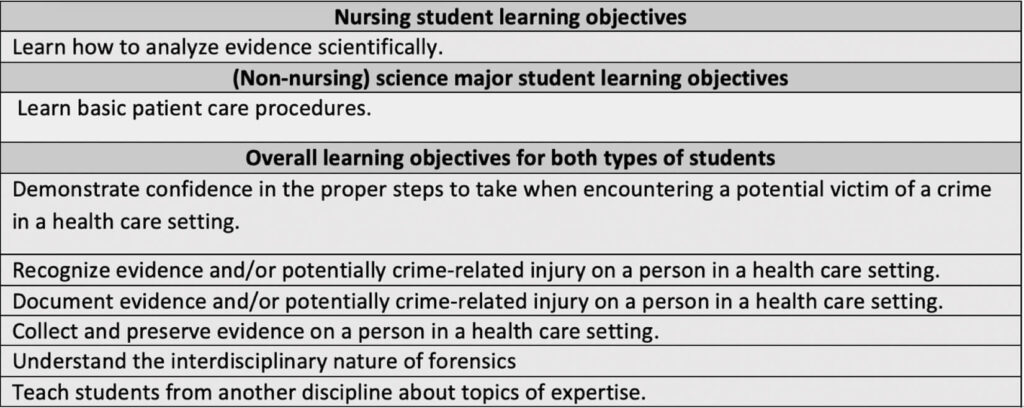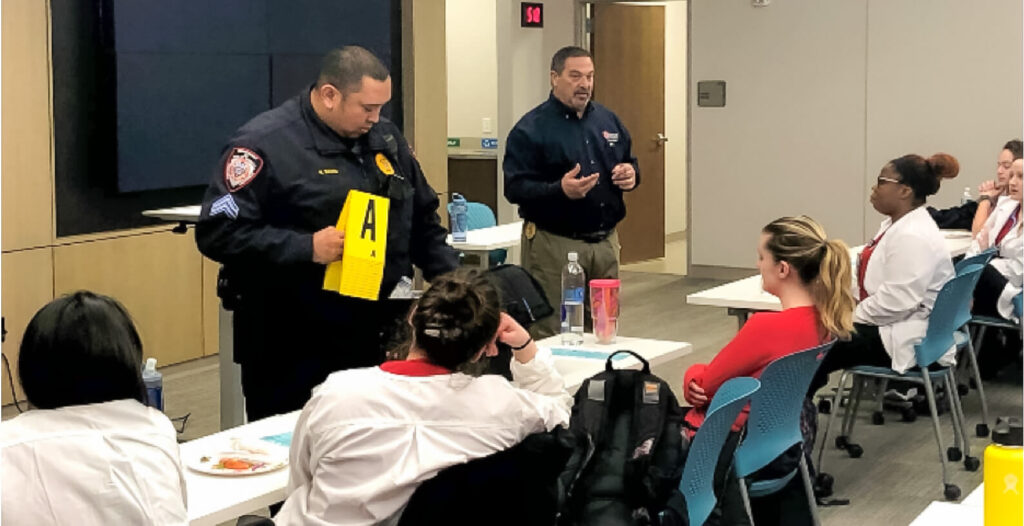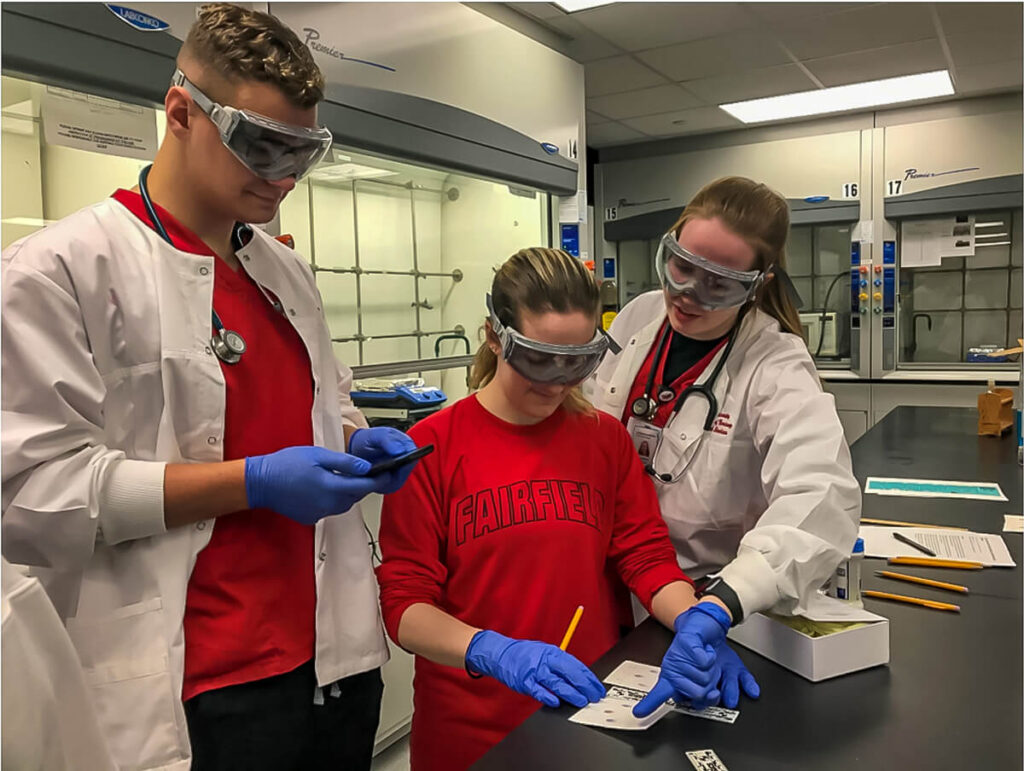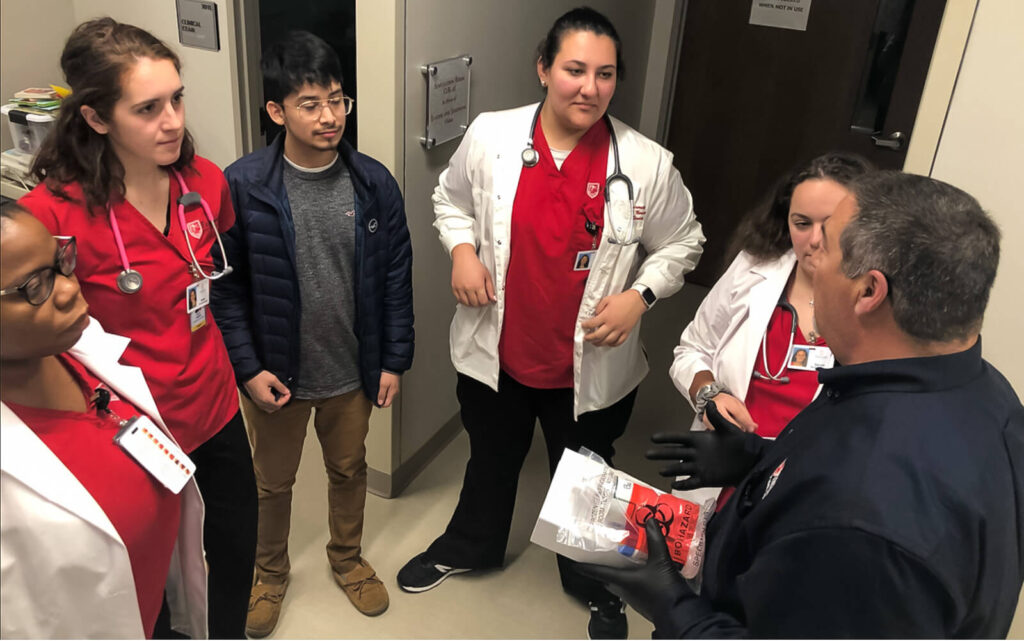A Collaboration Across Chemistry and the Health Sciences to Enhance Forensic Science Interdisciplinary Learning
Published in:
November 19–20, 2020
Virtual Symposium
Background
The two co-authors, from very different backgrounds, got to know each other through committee work at Fairfield University and discovered a common teaching and research interest in forensic science. Although the co-authors have taught in different disciplines, they found that some of their forensic science teaching goals could be achieved more effectively by working together. In nursing, there is a need for students to be familiar with best practices when encountering patients who may be victims of crimes, but clinical sites often limit a student’s ability to work with these types of patients. In addition, students may not understand the full implications of how their work with potential victims affects the forensic scientific analyses that can later be performed. In science, students may learn experimental skills and even forensic science experimental skills in certain classes, but may not understand the true interdisciplinary and collaborative nature of forensic science, especially as it applies to the medical realities of dealing with patients who may be victims of crime. Together, the co-authors developed an extra-curricular interdisciplinary evening event to enhance interdisciplinary forensic science education for both nursing and science students.
Learning Objectives
Each time the event was held, there were goals for nursing students, science majors (non-nursing students), and for both groups of students (Table 1). The event’s learning activities were carefully designed to synthesize theoretical content and apply it in new settings. The value of knowledge sharing was an aim that was promoted among all participants throughout all phases of the event.

Planning for the Events
In preparation for the events, the co-authors first worked together to secure an internal grant to support the expense of some of the experimental supplies used at the events and of the food served at the events. The co-authors developed a survey to administer to student participants prior to each event and following each event to gain insight into what students learned and took away from the events. Fairfield University Institutional Research Board (IRB) approval was also secured for data collection through surveys to the student participants. Finally, a Blackboard learning management system online community was formed to share information with participants, including links to the online surveys.
The event was planned and carried out once in October 2018 and once in January 2020. Colleagues from the department of public safety on campus were also invited to participate and played a crucial role in adding to the number of disciplines represented, and in adding realism to the scenarios. Graduate nursing students and upper-level science students also took leadership roles during different parts of the events to help facilitate the activities. Student participants were recruited through emails sent to upper-level nursing students, science students, and students interested in healthcare professions. We also posted flyers about the events in the nursing and science buildings. Fourteen students participated in October 2018 and thirteen students participated in January 2020. The students were split into three smaller groups to join in the evening activities.
Interdisciplinary Learning Event Structure
The interdisciplinary learning events were held for three hours in the evening. Each event began with a pizza dinner and an hour of information delivery by each of the co-authors concerning forensic scientific analysis and forensic science in the healthcare field. Also, colleagues from the department of public safety on campus presented information from the law enforcement perspective (Figure 1).

The nursing professor co-author shared how, in the clinical setting, nursing students are often unable to care for patients who are part of a forensic evaluation due to institution protocols. This leads to a gap in learning as students do not have the skills to care for these types of patients. Yet there may be an expectation upon graduation that they care for this patient population and participate in forensic evidence collection. All too often, nurses receive just-in-time training by a colleague when they need to do these activities at work for a patient, but the opportunity for error is too great and too much of a risk for those involved to be handled in this way.
The next part of the interdisciplinary learning event was aimed at helping nursing students gain experience considering what to do for a victim of a crime, and it gave science students a chance to learn how evidence and reference samples are collected from patients that can later be used in a crime laboratory during an investigation. After the presentation of introductory background material, a video was shared that showed an emergency room nurse giving information to the students about a mock crime scene scenario and a mock crime victim who had been admitted to the hospital. All students then went to the Egan School of Nursing and Health Studies Simulation Center for about a half-hour to “care” for a toddler mock crime victim (a high-fidelity human patient simulation), who had injuries that raised suspicion for child physical abuse. There were three simulated hospital rooms and patients, and the nursing students in each small group took the lead on the nursing assessment and care of the patient (Figure 2). They were prompted to share their knowledge with their science student colleagues assigned to the same patient room. The nursing and science students worked together to collect and preserve simulated evidence and reference samples from the patient. While maintaining the chain of custody, the nursing and science students provided these samples to the officer (from the Fairfield University department of public safety) who was waiting in the simulation center.

At the start of the event, the chemistry professor co-author presented on the field of criminalistics, or lab sciences, within the broad area of forensic science. Students learned about the different steps to take when a crime scene is encountered and the importance of evidence collection and handling procedures. Various types of evidence were reviewed, but in each event, one type of evidence was featured that would be the focus of the analysis for the evening. Fiber evidence and its analysis was discussed in detail in the first event held in 2018, and heavy metal evidence and its analysis was discussed in detail in the second event held in 2020. Each event featured its own unique mock crime scene scenario related to these different types of evidence.
Following the mock care of the mock crime victim and evidence collection portion of the event, the students went into the simulated crime laboratory and continued working in their small groups to rotate through three short experimental stations. Safety protocols were followed and all of the students wore gloves and safety goggles, long pants, lab coats, and closed-toe shoes. Any long hair was tied back, and no eating or drinking was allowed in the laboratory. Each experimental station was designed to take about 20 minutes, so that students could rotate through three stations in one hour.
During the 2018 event, students worked on experiments involving fiber analysis of fibers collected from the mock victim that were compared to blanket fibers found in suspect cars. The experiments included an infrared spectroscopic analysis, a burn analysis, and a differential staining analysis (Harper-Leatherman & Roney, 2019). In the 2020 event, students focused on lead analysis of the mock victim’s urine samples and milk samples due to a suspected heavy metal poisoning investigation. The experiments were completed using simulated lead for safety purposes. The experimental stations included identification of lead in liquid through a precipitation reaction, detection of heavy metal metabolites using chromatographic analysis (Figure 3), and an infrared spectroscopic analysis of heavy metal metabolites. Students walked away from the laboratory experience with an appreciation for the importance of how evidence is handled and how it is analyzed as part of the whole collaborative forensic investigation.

Students gathered in a classroom again at the end of each event for the last half hour, and a validated instrument, the PEARLS Debriefing tool (Eppich & Chen, 2015), was used by the two co-authors, after experiential learning in both the simulation center and the chemistry laboratory. Learners were able to provide a self-assessment at the beginning of the debriefing session. The faculty leaders then facilitated a focused discussion about the case’s details and provided direct feedback to participants. Each participant concluded the experience by sharing one takeaway from the learning activity (Figure 4).

Post-Event Findings
After each event, student participants self-reported increased ability to recognize and document evidence and/or potentially crime-related injury on a person in a healthcare setting and increased ability to collect and preserve the evidence (Harper-Leatherman & Roney, 2019). Students were able to take a broad view of how different professions work together to answer crime-related questions. The co-authors found satisfaction in their collaboration that had helped enhance students’ learning from various disciplines. By working together, each co-author achieved much more in the field of forensic science education than either could alone. Based on this success, it is clear that many other universities can implement similar events, as long as collaborators in the fields of science and nursing, in addition to public safety, are willing to work together.
Next steps for this project
The co-authors of this manuscript, Dr. Harper-Leatherman and Dr. Roney, received positive feedback from the participants immediately following the events and later. Some former participants have communicated that what they learned at the event was applied in their healthcare industry jobs. At this time, we have three other programs interested in replicating this project at their academic institutions. We invite others who might be interested to reach out to us.
Acknowledgments
We would like to acknowledge the support of our Egan School of Nursing and Health Studies Simulation Grant, the department of chemistry and biochemistry, Director Todd Pelazza and the many department of public safety officers at Fairfield, and our faculty colleagues who’ve supported our work, including Professor Susan Reynolds, Dr. Michael Andreychik, Dr. John Miecznikowski, Dr. Eileen O’Shea, Dr. L. Kraig Steffen, Dr. Dorothy Sobczynski, Dr. Matthew Kubasik, and Dr. Meredith Kazer. We would also like to thank our senior chemistry major lab assistants and graduate nursing assistants, and all the students who have taken part in our events over the years.
References
Eppich, W. & Cheng, A. (2015). Promoting excellence and reflective learning in simulation (PEARLS), Simulation in Healthcare, 10(2), 106-115. DOI: 10.1097/SIH.0000000000000072
Harper-Leatherman, A. S. & Roney, L. N. (2019) Interdisciplinary learning activity incorporating forensic science and forensic nursing. In Teaching Chemistry with Forensic Science; Harper-Leatherman, A. S., Huang, L. Eds.; ACS Symposium Series 1324; American Chemical Society: Washington, DC, Chapter 8; DOI: 10.1021/bk-2019-1324.ch008.
Harper-Leatherman, A. & Roney, L. (2018). Developing an interdisciplinary learning activity incorporating forensic science and forensic nursing. 25th Biennial Conference on Chemical Education, University of Notre Dame, Notre Dame, IN. July 31, 2018.
Roney, L. (2020). Images from the forensic nursing event at Fairfield University. Fairfield, CT, United States.
Roney, L. & Harper-Leatherman, A. (2019). Teamwork and collaboration: Caring for a pediatric non-accidental trauma patient. QSEN Institute Teaching Strategy Quality and Safety Education for Nurses.
https://qsen.org/teamwork-and-collaboration-caring-for-a-pediatric-non-accidental-trauma-patient/
Spring 2021: Curriculum Innovation for Transformative Learning
